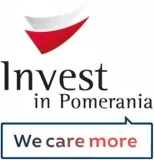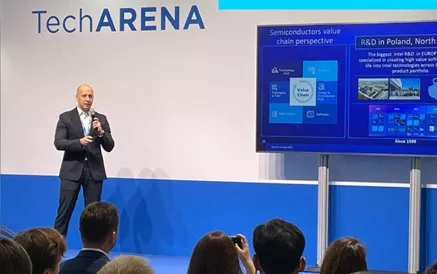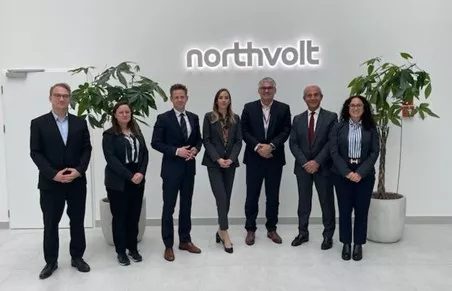
Increased investments in the European semiconductor industry are crucial for accelerating the development of sustainable technological solutions that support the industry’s global revenue projected to reach US$1 trillion by 2030. SEMI members are exploring new collaborations aimed at contributing to advancing semiconductor industry development in Europe and worldwide.
Over the past two years, powerhouses Bosch, CEA-Leti, Infineon Technologies, Intel, NXP, Soitec, TSMC, and Wolfspeed announced new investments and collaborative projects. Equally important, their efforts are aimed at devising solutions that help achieve net zero and overcome the chip industry’s talent pool shortages.
SEMI spoke with Mikolaj Trunin, Deputy Director of Invest in Pomerania, a regional non-profit organization that supports collaborative projects in the Pomeranian region Northern Poland. The initiative, coordinated by the Pomeranian Development Agency, is key in representing the interests of Pomeranian Voivodeship, focusing on promoting the region’s technological prowess to the global semiconductor market.
SEMI: Hello Mikolaj, thank you for joining the interview. For readers who might not be aware, where is Pomerania? Is there a connection between the region and the famous Pomeranian dog?
Trunin: This is a funny way to start our interview! I must confess the Pomeranian dog was our marketing campaign mascot last year, so the answer is, yes, they are related. The name Pomerania originates from the Slavic po more, which means by the sea. Geographically, Pomerania is the region situated on the southern shore of the Baltic Sea. The Tricity urban area consisting of Gdańsk, Gdynia, and Sopot is one of the main cultural, commercial and educational centers of Poland. Gdańsk and Gdynia are two major Polish seaports, while Sopot is a famous tourist destination.

Gdańsk harbor
SEMI: When did your organization begin exploring opportunities in the semiconductor industry?
Trunin: Two years ago we started collaborating with the World Bank to improve a strategy for the development of our region. The World Bank experts identified the semiconductor industry as one of the most promising in Pomerania. After the analysis, Invest in Pomerania shared a broader picture dedicated to this sector. The pandemic and geopolitical conflicts have disrupted the global supply chain, spurring a greater need for new investment projects and greater collaboration in Europe and worldwide. Before embarking on our journey to support the semiconductor ecosystem in Europe, we considered the following:
- What opportunities does Pomerania provide for foreign companies in the semiconductor industry? Can we count on new investments?
- Will the companies that already manufacture in our country grow?
- Are we likely to have a semiconductor factory?
In response to the challenges posed by the supply chain disruptions, the European Union strengthened cooperation among the member states. The European Chips Act allocated more than €43 billion of public and private investments to support semiconductor production, including fostering innovation throughout the supply chain to double Europe’s share in the global semiconductor market from 10% to at least 20% by 2030.
This is where our work comes into play. Our promotional efforts are aimed to contribute to Europe’s growth and ensure that the Pomeranian Voivodeship stands out as an attractive and promising location for semiconductor industry development in Central and Eastern Europe. For example, last year the region reserved a 200-hectare area for semiconductor investment!
SEMI: What makes Poland attractive for investment by the semiconductor industry?
 Trunin: The electronics sector has been the driving force of the Polish economy for years. Due to continuous technological advancements, the industry is characterized by a remarkable growth rate. Foreign-owned companies, which have been around since the 90s, remain the main players in the market and continue to launch new manufacturing plants in the country.
Trunin: The electronics sector has been the driving force of the Polish economy for years. Due to continuous technological advancements, the industry is characterized by a remarkable growth rate. Foreign-owned companies, which have been around since the 90s, remain the main players in the market and continue to launch new manufacturing plants in the country.
Among the largest electronics sector players investing in Poland are Samsung, Dell, and LG Electronics. In Pomerania, Intel has its largest R&D center in Europe. Companies such as Flex and Lacroix have also invested in large production facilities in Pomerania. Those companies are steadily increasing their production capacities which indicates a positive perception of Poland and Pomerania as a foreign direct investment (FDI) destination.
SEMI: What about the automotive sector and the trends for electrification?
Trunin: Poland is one of the largest producers of cars and car parts in Europe. Over the years Poland has focused on consumer electronics and has created a fairly strong cluster in central Poland, developing a unique value proposition to leverage synergies and integration opportunities in segments such as mobility, artificial intelligence (AI) and smart manufacturing. Trends in the automotive industry and its progressive electrification have set the scene for Pomeranian companies to grow in the electronics sector.
By 2030, electronic components are expected to account for up to half the cost of a car. Vehicles with autonomy level will need eight to 10 times more electronic components than those with zero autonomy capabilities. This means that as the automotive sector grows, its ties to the semiconductor industry will continue to grow.
The Pomeranian automotive sector stands out from other Polish regions as a supplier of technologies and components for autonomous and electric vehicles. Nearly 21,300 people are employed at key companies based in the region, including Aptiv, Flex, Intel, Northvolt, and Nippon Seiki. Eaton is currently increasing its e-mobility production capacity.
SEMI: What can you tell us about the state of education and available talent pool in Pomerania?
 Trunin: Our region hosts the largest university centers in Northern Poland. The university that meets the needs of the industry to the greatest extent is Gdansk University of Technology. Its 13 faculty members educate about 5,400 students in competencies critical for the electronics industry, mainly from the Departments of Electronics, Telecommunications and Informatics, which were recognized by the Polish government with the highest grade in the national evaluation for the quality of their scientific and R&D activities.
Trunin: Our region hosts the largest university centers in Northern Poland. The university that meets the needs of the industry to the greatest extent is Gdansk University of Technology. Its 13 faculty members educate about 5,400 students in competencies critical for the electronics industry, mainly from the Departments of Electronics, Telecommunications and Informatics, which were recognized by the Polish government with the highest grade in the national evaluation for the quality of their scientific and R&D activities.
Additionally, there are almost 10,000 students in key vocations for the electronics industry. Jobs such as automation and mechatronics technicians, ICT engineers and telecommunications equipment installers are in high demand.
A broad talent pool is a massive advantage of Northern Poland! The Tricity is the best area for relocation in Poland.
SEMI: Is that the region’s answer to the semiconductor industry’s talent shortage? Are there initiatives promoting the participation of women in technology industries?
Trunin: According to our studies, there is still much to be done. Within the scope of Invest in Pomerania, we created a new division called Talent Attraction to undertake various projects aimed at enhancing the educational ecosystem for priority industries in the Pomeranian region such as:
- Talent Bank, a tool dedicated to supporting investors by providing talent with the desired skills
- Job fairs to attract new talent to the region
- Parent-Friendly Pomerania to support careers among parents
- Business and universities cooperation, creating relations between investors and Pomeranian universities, Technology Transfer Centers (TTC) and career offices
- Skill Sprint, a university conference promoting employers from key industries
We also organize a variety of initiatives tailored to the migrant community in our region, exemplified by events like Let’s Meet: Pomerania. Additionally, we support employees’ relocation processes by facilitating connections between entrepreneurs, migrants, and relevant public agencies.
The industry’s collaboration with universities and vocational schools is key to attracting high-skilled workers to its manufacturing facilities. Chip companies emphasize that their workforce development initiatives are not a substitute for systemic and long-term actions aimed at increasing the attractiveness of technical curriculum and specializations. One of the most interesting industry initiatives is the co-creation of courses at the postgraduate studies of Gdansk University of Technology titled The Future of the Company, Electronics Manufacturing Engineering and Quality Assurance in the Engineering Industry. These are joint initiatives lead by the university with the participation of local companies such as Assel, Flex, Interizon ICT Cluster, Jabil Circuit Poland, Kitron, Lacroix Electronics, Northvolt and Radmor.
The programs combine theoretical and practical knowledge and most classes are taught by industry experts. Graduates of the courses later landed engineering positions at local companies. What's more, Intel Poland has launched an initiative to heighten awareness of STEM educational opportunities among diverse groups. Participants are mainly children and adolescents at different stages of education and women.
The proportion of women in STEM in Poland is above the EU average. Initiatives encouraging female high school students to study STEM such as the Girls as Engineers! Girls go Science! campaigns are thriving in Poland. At the forefront of this educational transformation is the Pomeranian Voivodeship
In addition, Intel and Interizon ICT are taking steps to increase women's participation in the IT sector. The aim of the IT for SHE and New Technologies for Girls programs is to help talented female students enter the job market and plan their careers and further professional development. The two companies also host an annual festival for women in technology called Intel Women in Tech Days.
Noteworthy are programs that inspire children and young people to work with AI, such as the Pomeranian Wizard, for elementary school students, and AI for Youth, for secondary and vocational schools. The latter is an educational program focused on giving participants the key competencies needed to understand and work with artificial intelligence. The 90-hour practical classes are offered in cooperation with the Polish government and organizations supporting modern education in Poland.

New Intel facility and technology campus in Gdańsk
SEMI: Your agency became a SEMI Europe member last year and has since participated in SEMICON events around the world. What are the key takeaways of your first SEMICON Europa participation?
Trunin: We are proud members of SEMI and since last year we increased our network within the semiconductor industry in Europe and globally. We aim to raise awareness about investment opportunities in Northern Poland amidst numerous changes and projects in the semiconductor field coming into Europe. Our participation at SEMICON shows in Taiwan, Europe, Japan, United States and soon in Korea helped us to connect with a large pool of microelectronics industry experts.
Invest in Pomerania was a silver sponsor of SEMICON Europa 2023 in Munich and also exhibited. Our team had a tremendous chance to champion the region as one of the most attractive for semiconductor industry investments. In fact, Invest in Pomerania was the first entity in Poland to join SEMI! This allowed us to be exposed to over 3,000 member companies and institutions representing the world’s largest chip manufacturers and the broader electronics sector.
Participation at SEMICON Europa and other events granted us continuous presence within the semiconductor ecosystem in 2023. Additionally, Invest in Pomerania co-hosted a panel discussion at the SEMICON Europa Future Disruptions session, where Mieszko Dropiński, Tech Advisor to DCAI and NEX Poland and General Manager at Intel, addressed challenges in the advanced packaging system and showcased the region’s potential in the global supply chain.

Mieszko Dropiński, Tech Advisor to DCAI and NEX Poland and General Manager at Intel
We truly appreciated the SEMI Europe team visit in Gdańsk in October 2023. It gave us the opportunity to showcase the region’s potential and the excellence of some of our greatest partners such as Intel Poland and Northvolt.

SEMI Europe team members visit at Northvolt in Gdańsk (left to right): Radosław Młynarczyk PR & Marketing Project Manager, Anna Częścik – Szalewska Industrial Sectors Promotion Senior Associate, Mikołaj Trunin Deputy Director, Invest in Pomerania; Cassandra Melvin, Senior Director Operations and Business Development at SEMI Europe; Robert Chryc-Gawrychowski General Manager at Northvolt Systems Poland; Laith Altimime, President of SEMI Europe; Serena Brischetto, Director Marketing and Digital Engagement at SEMI Europe.
SEMI: What will Invest in Pomerania focus on in 2024?
Trunin: Some of the world’s most recognizable brands chose Pomerania and now develop their technologies in our region. We are very proud to promote the region’s technological excellence around the world and will work harder to support technology innovation and increase the competitiveness of our region and the semiconductor industry. In 2024 and in the following years, we intend to become even more visible on the international stage. Our portal dedicated to the semiconductor industry will soon become a knowledge hub about what's happening in the industry in our region. We will invest in collaborating with companies, institutions, and universities, providing ongoing support to our investors at every stage of their projects.
Mikolaj Trunin is Deputy Director of Invest in Pomerania.
Serena Brischetto is Director of Marketing and Digital Engagement at SEMI Europe.